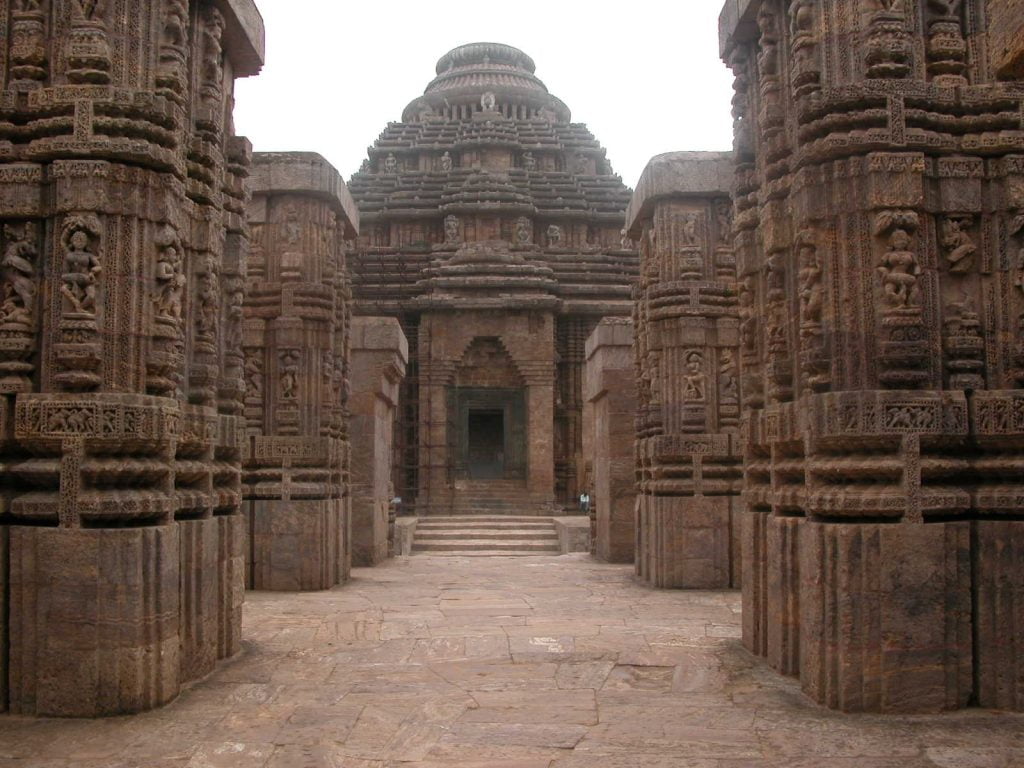Konark Sun temple complex is in the shape of a gigantic chariot, having elaborately carved stone wheels, pillars and walls. A major part of the structure is now in ruins. The temple is a UNESCO World Heritage Site and has also featured on the various list of Seven Wonders of India.
Shrine’s History
According to Bhavishya Purana and Samba Purana, there may have been a sun temple in the region earlier than current one, dating to the 9th century or earlier. The books mention three sun temples at Mundira , Kalapriya , and Multan. According to the scriptures, Samba, the son of Krishna, was cursed with leprosy. He was advised by the sage, Kataka, to worship the sun god to cure his ailment. Samba underwent penance for 12 years in Mitravana near the shores of Chandrabhaga. Both the original Konark temple and the Multan temple have been attributed to Samba. The Periplus of the Erythraean Sea mentions a port called Kainapara, which has been identified as current day Konark.
Legends Associated with This Shrine
While bathing in the river on the following day, he found an image of God, fashioned out of Surya’s body by Viswakarma. Samba installed this image in a temple built by him in Mitravana, where he propitiated the God. Since then, this place has been regarded as sacred. In ancient times worship of Sun god was in vogue and the people were accustomed to the worship of two Supreme deities–one mother Earth as Dharitri Mata and the other the Sun, the Dharam devata.
Sun god is regarded as the supreme lord of the universe and the prime object of life-giving energy, being the healer of diseases and bestower of desires.
Architectural Relevance of This Shrine
The temple was originally built at the mouth of the river Chandrabhaga, but the water line has receded since then. The temple has been built in the form of a giant ornamented chariot of the Sun god, Surya. It has twelve pairs of elaborately carved stone wheels which are 3 meters wide and is pulled by a set of seven horses . The temple follows the traditional style of Kalinga architecture. It is carefully oriented towards the east so that the first rays of sunrise strikes the principal entrance. The temple is built from Khondalite rocks.
The original temple had the main sanctum sanctorum , which was supposedly 229 feet tall. Due to the weight of the superstructure and weak soil of the area, the main vimana fell in 1837. The audience hall , which is about 128 feet tall, still stands and is the principal structure in the surviving ruins. Among the structures, which have survived to the current day, are the dance hall and dining hall . The Konark temple is also known for its erotic sculptures of maithunas. Two smaller ruined temples have been discovered nearby.
One of them is called the Mayadevi Temple and is located south-west of the entrance of the main temple. It is presumed to have been dedicated to Mayadevi, one of the Sun god’s wives. It has been dated to the late 11th century, earlier than the main temple. The other one belongs to some unknown Vaishnava deity. Sculptures of Balarama, Varaha and Trivikrama have been found at the site, indicating it to be a Vaishnavite temple. Both temples have their primary idols missing. A collection of fallen sculptures can be viewed at the Konark Archaeological Museum which is maintained by the Archaeological Survey of India.
Shrine’s Map Location and How to Go There
By Road
An extensive road network connects Konark with the rest of the India via National as well as State Highways.
By Rail
Railway stations closest to Konark are there in the twin cities of Puri and Bhubaneswar.
By Air
Bhubaneswar airport is the nearest airport that is well linked and has regular flights from all parts of the country. This airport is at a distance of 64 km from Konark.
Shrine Timings
6AM?8PM
Extra Information About this Shrine
Fall of the Konark Sun Temple
Many theories explain the fall of the temple in their own way. As per one theory, part of the Konark temple collapsed because of its incomplete structure. The Konark Sum Temple was not completed because of the early death of the king Langula Narasimha Dev who initiated the construction of the temple. Next is the theory of lodestone located at the top of the temple. The lodestones placement caused a huge damage to the temple as many vessels passing through the Konark Sea were attracted towards it.
Also, this magnet used to disturb the compass of almost all the ships in the sea. So, to remove the cause of the trouble, Portuguese voyagers stole the lodestone. The displacement of the lodestone led to total imbalance and so the Konark temple fell down. But there is no historical record either of this event or presence of such a great lodestone at Konark. As per another very popular theory, the temple was destroyed by Kalapahad who invaded Orissa in 1508. He had also destroyed many other Hindu temples in Orissa along with the Konark Sun Temple. In 1568, Muslims started ruling Orissa and destroyed many Hindu temples.
